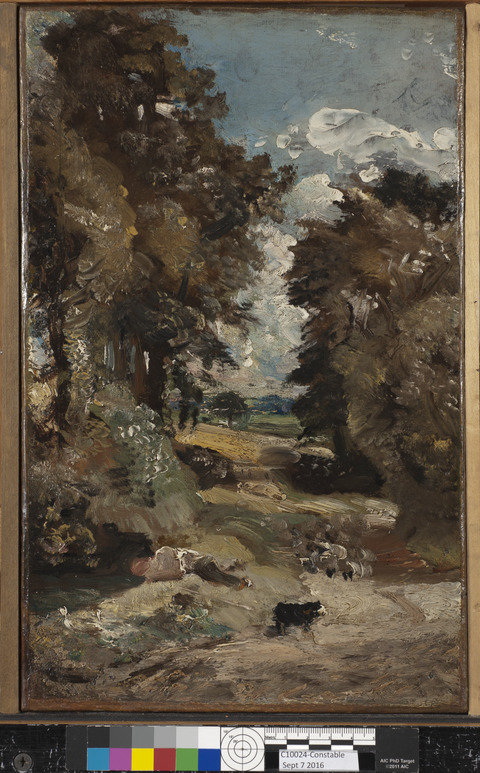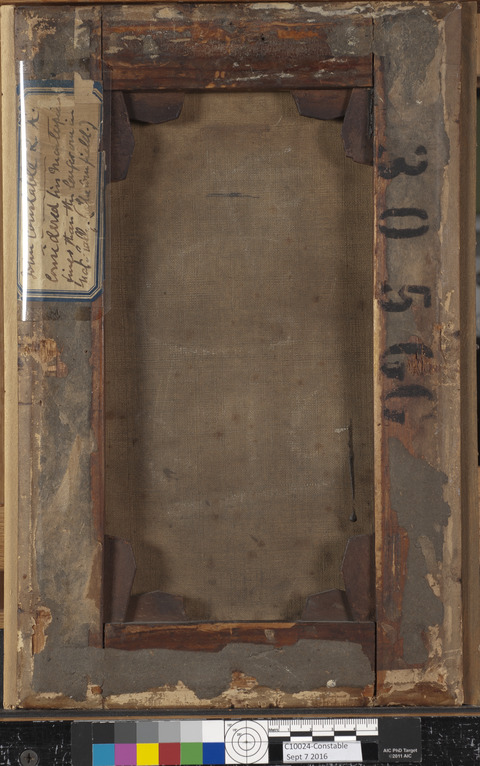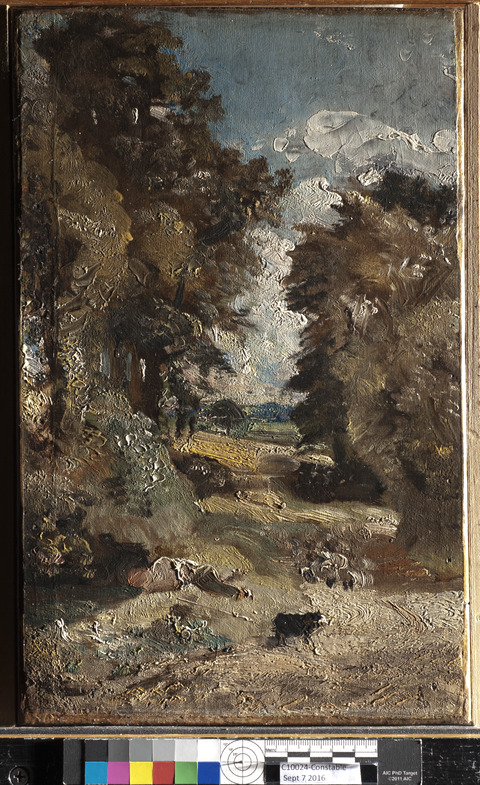Overview
Accession number: 2009.53
Artist: John Constable
Title: The Cornfield
Materials: Oil (untested) on canvas
Date of creation: About 1816
Previous number/accession number: C10024
Dimensions: 31.6 × 24.9 cm
Conservator/examiner: Fiona Beckett with contributions from Roxane Sperber
Examination completed: 2016, revised 2018
Distinguishing Marks
Front:
None
Back:
Item 1. Rectangular label (white with a double blue border) on back of left stretcher bar, covered in Mylar: “John Constable R.A. Considered his masterpiece/ finer than his larger one in/ Nat. Gallery (The Cornfield)” (tech. fig. 1).
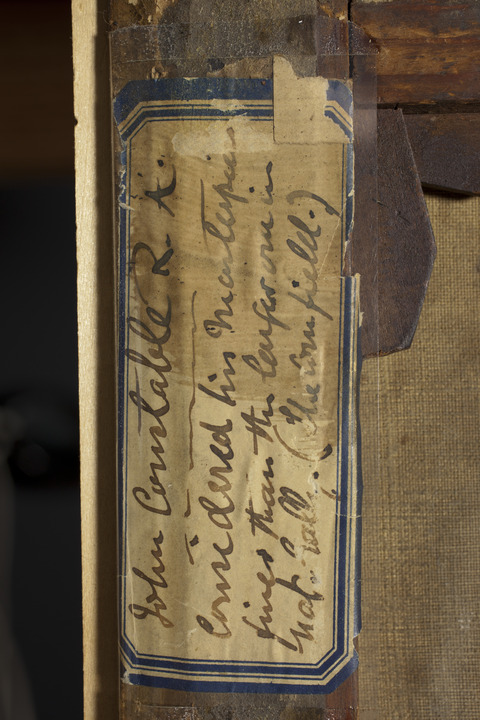
Item 2. Large, black lettering on back of right stretcher bar: “305GG” (tech. fig. 2).
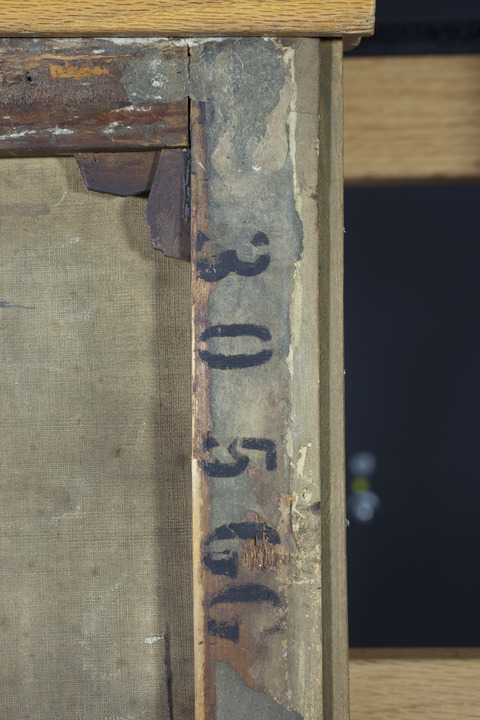
Summary of Treatment History
Physical evidence suggests that the painting underwent some conservation interventions, including lining, prior to its arrival at the IMA. Documentation suggests a series of condition assessments and treatments were carried out on the collection around the time the works were moved from the Clowes residence to the IMA in 1971. A condition report by Paul Spheeris in October of that year, likely carried out before the paintings were relocated, described the painting as “O.K.” He recommended cleaning the painting for the sake of the work’s appearance but not for the stability of the paint layer.1 A second condition assessment was carried out upon arrival of the paintings at the IMA. This assessment describes the work as being in good condition, and no treatment was deemed necessary.2
In 1996, a memorandum summarizing treatment and examination of the Clowes Collection from the time it entered the Museum suggests that the painting was examined and treated in 1988. Scholarly examination was also conducted by Charles Rhyne.3 Treatment was carried out by David Miller, as indicated by notes in the IMA file dated 29 April. The treatment included surface dirt removal, varnish removal, spray application of Paraloid B-72, inpainting with Lefranc and Bourgeois Couleurs Pour La Restauration (mixture of acrylic and ketonic resins), and a final varnish application of Laropal K-80.
The painting was inspected in the Clowes Collection annual survey from 2011 to 2020.
Current Condition Summary
Structurally, the painting is in good condition. The work has remained in a stable environment with very few shifts in temperature and relative humidity and does not show signs of distress. Aesthetically, the painting is in good condition.
Methods of Examination, Imaging, and Analysis
| Examination/Imaging | Analysis (no sample required): | Analysis (sample required): |
|---|---|---|
| Unaided eye | Dendrochronology | Microchemical analysis |
| Optical microscopy | Wood identification | Fiber ID |
| Incident light | Microchemical analysis | Cross-section sampling |
| Raking light | Thread count analysis | Dispersed pigment sample |
| Reflected/specular light | X-ray fluorescence spectroscopy (XRF) | Fourier-transform infrared spectroscopy (FTIR) |
| Transmitted light | Macro X-ray fluorescence scanning (MA-XRF) | Raman microspectroscopy |
| Ultraviolet-induced visible fluorescence (UV) | ||
| Infrared reflectography (IRR) | Gas chromatography–mass spectrometry (GC-MS) | |
| Infrared transmittography (IRT) | Scanning electron microscope -energy dispersive X-ray spectroscopy (SEM-EDS) | |
| Infrared luminescence | Other: | |
| X-radiography |
Technical Examination
Description of Support
Analyzed Observed
Material (fabric, wood, metal, dendrochronology results, fiber ID information, etc.):
The painting is executed on canvas. The original canvas is set in from the lining canvas by approximately 2–4 mm. The original canvas is plain weave. The thread count of the original canvas is 12 × 15 threads/cm with more threads in the horizontal orientation (see tech. fig. 3).4
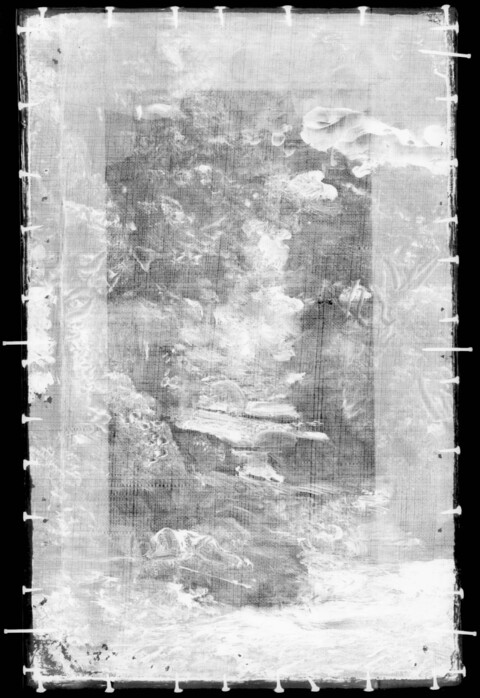
Characteristics of Construction / Fabrication (cusping, beveled edges of panels, seams, joins, battens):
Under the microscope, old tacking holes are visible along the left, right, and bottom edges of the painting (tech. fig. 4).5 When sketching in nature, Constable is known to have pinned scraps of canvas to his sketching box.6 These holes provide evidence that The Cornfield may have been tacked in this way while it was painted. Photomicrographs of the unfilled holes show the original paint layer continuous across the hole, suggesting the paint may have been applied over the pins. A crease is also visible on the left side of the canvas in X-radiograph (tech. fig. 3) and raking light but does not appear to have disrupted the original paint layer. This suggests the crease was flattened before painting began. The canvas may have been the edge of a reused canvas.7 Constable often cut his supports for his oil sketches from larger primed canvases that he purchased and cut to a smaller size so that they could be carried in his sketching box and pinned to the lid.8
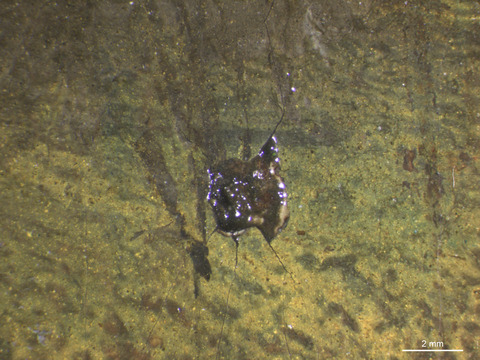
Thickness (for panels or boards):
N/A
Production/Dealer’s Marks:
None
Auxiliary Support:
Original Not original Not able to discern None
The auxiliary support includes a four-member butt-jointed mortise and tenon stretcher with eight keys. The edges of the four stretcher members are beveled to avoid stretcher bar deformations in the paint layer. The painting is glue-lined to a densely woven plain-weave canvas. Brown liner tape is present along all edges but has been removed along the upper tacking margin, presumably to inspect the edge of the composition in this area. Two edge strips were added to either side of the painting to facilitate framing.
Condition of Support
The canvas support is in good condition. There is good adhesion between the support and the lining canvas with no visible areas of delamination. The stretcher is discolored with several nicks and dents from general wear over time. All eight stretcher keys are present. Rust from the lining tacks has deteriorated the brown paper tape.
Description of Ground
Analyzed Observed
An off-white ground is visible along the top edge (tech. fig. 5). A brown imprimatura layer is clearly visible in the sky area and appears to extend across the entire canvas. A similar ground structure has been identified on canvases from 1811 to 1821.9 A similar imprimatura has also been noted on Constable oil sketches on paper, also painted en plein air, in Brighton during the mid-1820s.10
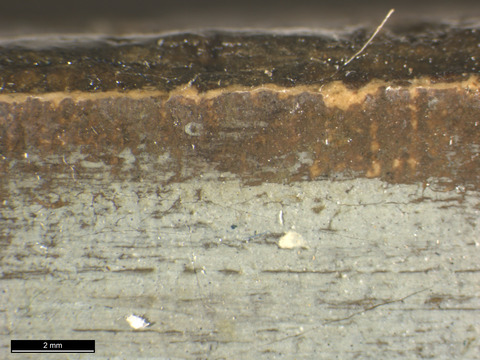
Materials/Binding Medium:
Although the binding medium was not analyzed it appears to be oil.
Color:
The ground is off-white in color.
Application:
The ground was likely brush applied.
Thickness:
The ground is relatively thin in its application.
Sizing:
While difficult to determine without further testing, the canvas would have likely been sized prior to painting.
Character and Appearance (Does texture of support remain detectable / prominent?):
The texture of the canvas remains prominent in some areas. In areas of rich impasto, the support is concealed.
Condition of Ground
The ground layer exhibits a cracking network consistent with natural aging. This can be seen through the paint layers. The adhesion of the ground remains strong to both the support and the paint layer.
Description of Composition Planning
Methods of Analysis:
Surface observation (unaided or with magnification)
Infrared reflectography (IRR)
X-radiography
Analysis Parameters:
| X-radiography equipment | GE Inspection Technologies Type: ERESCO 200MFR 3.1, Tube S/N: MIR 201E 58-2812, EN 12543: 1.0mm, Filter: 0.8mm Be + 2mm Al |
|---|---|
| KV: | 21 |
| mA: | 3 |
| Exposure time (s) | 120 |
| Distance from X-ray tube: | 36″ |
| IRR equipment and wavelength | Opus Instruments Osiris A1 infrared camera with InGaAs array detector operating at a wavelength of 0.9-1.7µm. |
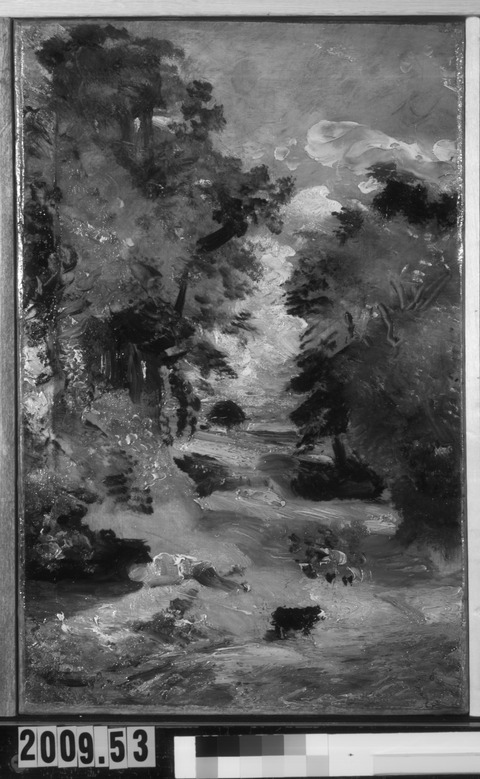
Medium/Technique:
No underdrawing is visible in the infrared reflectogram.
Pentimenti:
No pentimenti are discernible in the painting. This is not surprising given the sketch-like quality of the work. Some of the paint appears darker in the infrared reflectogram due to the infrared-absorbent nature of some pigments (such as carbon-containing pigments) in the infrared region of the spectrum (tech. fig. 6).
Description of Paint
Analyzed Observed
Application and Technique:
The painting was likely painted in one sitting, en plein air. The paint is applied thickly, using a wet-in-wet technique with energetic brushwork. Varied brushstrokes across the composition create energy and depth in the painting and a texture that is very much part of the aesthetic of the work. Over the brown imprimatura, which serves as a midtone, Constable stippled paint with a stiff brush to create the foliage of the trees and clouds in the sky (tech. figs. 7, 8). In the middle and foreground, long, linear brushstrokes with a soft-bristled brush accentuate the horizon line and the long trunks of trees (tech. fig. 9). In areas of the sky, a palette knife was used to create a smooth cloud that contrasts with the stippled texture of the rest of the sky (tech. fig. 11).
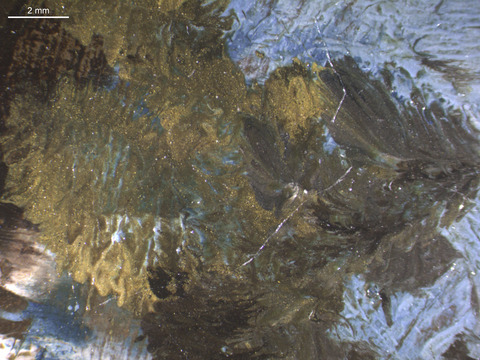
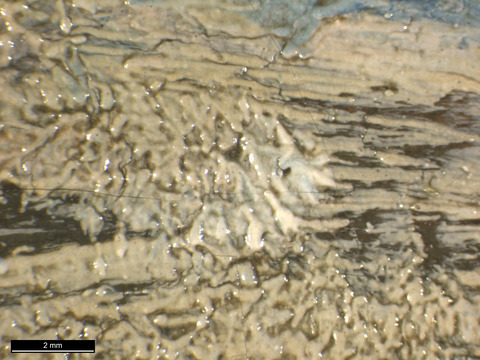
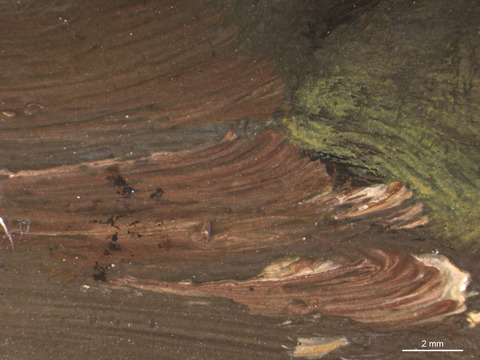
Pure white dabs of paint were applied last in the cloud and areas of the foliage (tech. fig. 10). Most colors were mixed before being applied to the canvas; however, minor blending occurs at the edges of the wet-in-wet brushstrokes (tech. fig. 15).
Painting Tools:
Brushes (medium size) and a palette knife were used. A hard-bristled brush appears to have been used in some areas of the canvas to create stippled texture in the paint. In the foreground and middle ground, the paint is applied with a softer brush in thick, linear strokes. Some of the paint was applied to the canvas with a hard-edged tool such as a palette knife.11 This is particularly noticeable in the clouds.
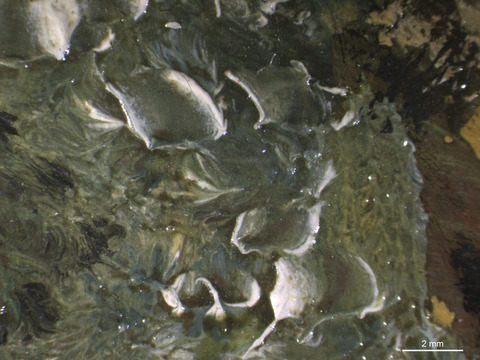
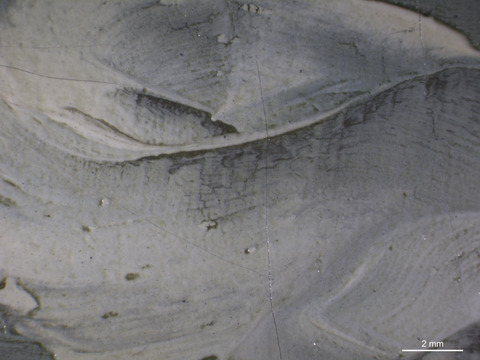
Binding Media:
Although the binding media was not tested, it is likely drying oil.
Color Palette:
A relatively limited color palette composed primarily of earth-toned greens, browns, and yellows was used in the painting. Two blues are identifiable—a darker blue in the horizon and a lighter blue in the sky. The blue in the sky has been identified using Raman spectroscopy as Prussian blue, and it is likely that the dark blue is also Prussian blue with less white mixed in (tech. fig. 12). Pure black and pure white are used for highlights and lowlights. The pigments used to paint the black cow strongly absorb in the infrared reflectogram, suggesting the use of carbon-containing black in this area. Analysis by XRF indicates the presence of lead throughout the painting in large amounts, most likely used in the ground layer (tech. fig. 14). Calcium is another likely component of the ground since it was also found throughout the painting. Iron was present in all sampled areas, indicating that iron oxides were used in large quantities throughout. This may also be a result of the brown imprimatura layer. The primary yellow appears to have been yellow ochre. Photomicrographs of the green area show a mixture of pigments, suggesting the greens may be mixtures of Prussian blue and yellow ochre (tech. fig. 13). Traces of vermilion were found, as were traces of titanium white and zinc white, likely from inpainting.

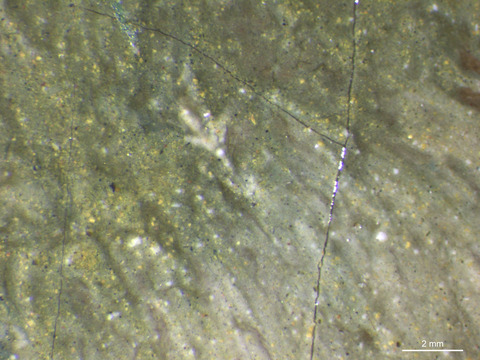
XRF Analysis:
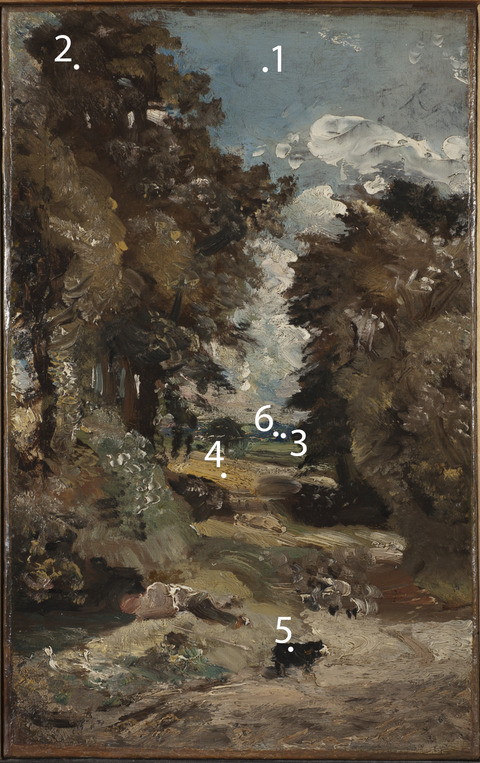
| Sample | Location | Elements | Possible Pigments |
|---|---|---|---|
| 1 | Blue in sky (central) | Major: Pb Minor: Fe Trace: Ca, Mn, Ti | Lead white, iron oxide (earth pigments), likely Prussian blue, trace of titanium (likely impurity from earth pigments), trace of calcium (likely from ground layer), trace of manganese from umber pigment (or iron oxide impurity). |
| 2 | Green in trees (top left) | Major: Pb, Fe Minor: Mn, Ca Trace: Cu, K, Hg, Ti | Lead white, iron oxide (earth pigments including green earth and umber), calcium (likely from ground layer), trace of copper-containing green or blue pigment, trace of titanium (likely impurity from earth pigments), trace of vermilion. |
| 3 | Purple in distance (central) | Major: Pb Minor: Fe, Ca Trace: Mn, Al, K | Lead white, iron oxide (earth pigments including green earth), likely Prussian blue, calcium (likely from ground layer), trace of titanium (likely impurity from earth pigments), trace of manganese from umber pigment (or iron oxide impurity). |
| 4 | Yellow in center | Major: Pb, Fe Minor: Ca, K, Mn Trace: Cu, Al, Ti, Zn | Lead white, iron oxide (earth pigments including green earth and umber), calcium (likely from ground layer), trace of titanium (likely impurity from earth pigments), trace of copper-containing green or blue pigment. |
| 5 | Black in cow | Major: Pb, Fe Minor: Mn, Ca, K Trace: Ti, Zn, Hg, Cu | Lead white, iron oxide (earth pigments including green earth and umber), carbon black, calcium (likely from ground layer), trace of copper-containing green or blue pigment, trace of manganese from umber pigment (or iron oxide impurity), trace of titanium (either from titanium white inpainting or as an impurity from earth pigments), trace of zinc (likely from inpainting), trace of vermilion. |
| 6 | Dark blue in distance (central) | Major: Pb, Fe Minor: Ca Trace: K, Mn, Cu, Ti | Lead white, likely Prussian blue, iron oxide (earth pigments including green earth), calcium (likely from ground layer), trace of copper-containing green or blue pigment, trace of manganese from umber pigment (or iron oxide impurity), trace of titanium (likely impurity from earth pigments). |
Table 1: Results of X-ray fluorescence analysis conducted with a Bruker Artax microfocus XRF with rhodium tube, silicon-drift detector, and polycapillary focusing lens (~100 μm spot).
*Major, minor, trace quantities are based on XRF signal strength not quantitative analysis
Surface Appearance:
The surface exhibits some thick areas of impasto and rich brush strokes. No smaller details are incorporated (tech. fig. 15).
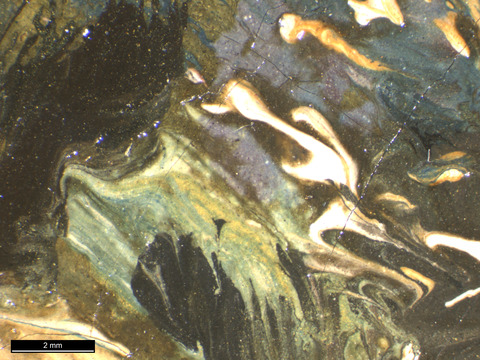
Condition of Paint
The paint is in good condition. Although the painting was lined and experienced several cleaning campaigns, the paint exhibits little to no abrasion or flattening. A cracking network, extending from the ground layer, is present over the surface due to the natural aging process of the canvas and paint. Larger tension cracking is present in the sky area, likely from the canvas being stretched onto the new stretcher.
Description of Varnish/Surface Coating
Analyzed Observed Documented
| Type of Varnish | Application |
|---|---|
| Natural resin | Spray applied |
| Synthetic resin/other | Brush applied |
| Multiple Layers observed | Undetermined |
| No coating detected |
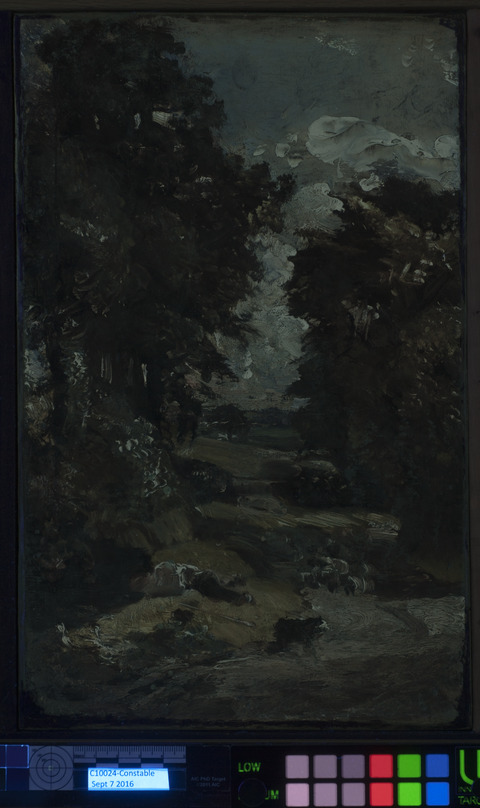
Several layers of varnish are present. Examination under ultraviolet-induced visible fluorescence indicate that a synthetic varnish is present over the surface of the painting. Documentation confirms the presence of a Laropal A81 varnish, applied in the late 1980s (tech. fig. 16). Residues of a natural resin varnish are present in some areas. This is likely the result of a “French polish” technique that was used during the 1988 treatment to distribute the remaining residues of natural resin varnish over the entire surface of the painting in the previous conservation campaign.12 Inpainting is present primarily around the edges and corners and in small amounts in the composition.
Condition of Varnish/Surface Coating
The varnish is in good condition and adequately saturates the painting. The inpainting remains intact and does not appear to have discolored over time.
Description of Frame
Original/first frame
Period frame
Authenticity cannot be determined at this time/ further art historical research necessary
Reproduction frame (fabricated in the style of)
Replica frame (copy of an existing period frame)
Modern Frame
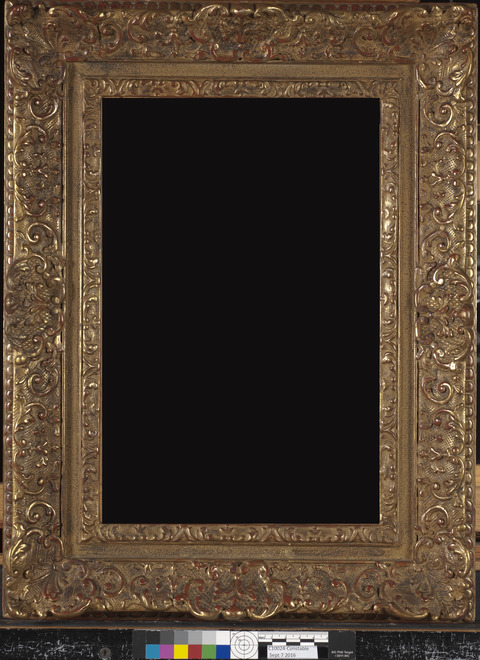
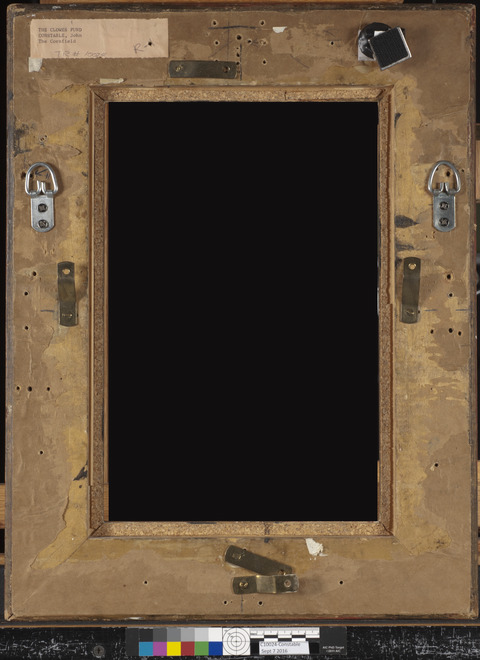
Frame Dimensions:
Outside frame dimensions: 45.6 × 34.8cm
Sight size: 31.2 × 20.4 cm
Distinguishing Marks:
Item 3. Off-white label, back of upper frame member, with typing: “THE CLOWES FUND CONSTABLE, John The Cornfield” and handwritten “TR#10024 R-1” (tech. fig. 19).
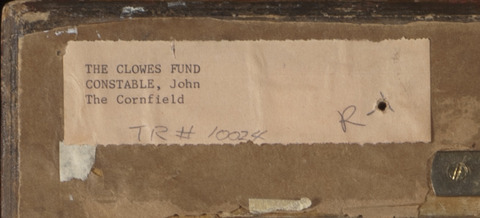
Description of Molding/Profile:
The frame is composed of four members with mitered corners (tech. figs. 17, 18).
Condition of Frame
The frame is structurally sound and in good condition.
Notes
-
Paul A.J. Spheeris, “Conservation Report on the Condition of the Clowes Collection,” 25 October 1971, Conservation Department Files, Indianapolis Museum of Art at Newfields. ↩︎
-
Martin Radecki, Clowes Collection condition assessment, undated (after October 1971), Conservation Department Files, Indianapolis Museum of Art at Newfields. ↩︎
-
Memorandum from Martin Radecki to Bret Waller, “Conservation Work on Clowes Fund Collection,” 16 February 1996, Conservation Department Files, Indianapolis Museum of Art at Newfields. ↩︎
-
This type of canvas closely conforms to Constable’s most common painting support. See Sarah Cove, “Constable’s Oil Painting Materials and Techniques,” in Constable, ed. Leslie Parris and Ian Fleming-Williams, exh. cat. (London: Tate Gallery, 1991), 495. ↩︎
-
This was first noted by David Miller and Charles Rhyne during the 1988 examination and treatment of the painting. ↩︎
-
Mark Evans, Nicola Costaras, and Clare Richardson, John Constable: Oil Sketches from the Victoria and Albert Museum (London: V&A Publishing, 2011), 148. ↩︎
-
The practice of incorporating tacking margins into his final compositions as a means of resizing or recycling canvas has been noted in Mark Evans, Nicola Costaras, and Clare Richardson, John Constable: Oil Sketches from the Victoria and Albert Museum (London: V&A Publishing, 2011), 149. ↩︎
-
Sarah Cove, “Constable’s Oil Painting Materials and Techniques,” in Constable, ed. Leslie Parris and Ian Fleming-Williams, exh. cat. (London: Tate Gallery, 1991), 495. ↩︎
-
Mark Evans, Nicola Costaras, and Clare Richardson, John Constable: Oil Sketches from the Victoria and Albert Museum (London: V&A Publishing, 2011), 151. ↩︎
-
Rica Jones, “John Constable (1776–1837) Beaching a Boat, Brighton 1824,” in Paint and Purpose: A Study of Technique in British Art, ed. Stephen Hackney, Rica Jones, and Joyce Townsend (London: Tate Gallery Publishing, 1999), 196–197. ↩︎
-
The use of a palette knife in Constable’s painting has been frequently noted in descriptions of Constable’s painting technique. See Robert C. Leslie, Life and Letters of John Constable, R.A. (London: Chapman and Hall, 1896), 257. ↩︎
-
David Miller, conservation treatment report C10024 (2009.53), 29 April 1988, Conservation Department Files, Indianapolis Museum of Art at Newfields. ↩︎
Additional Images
